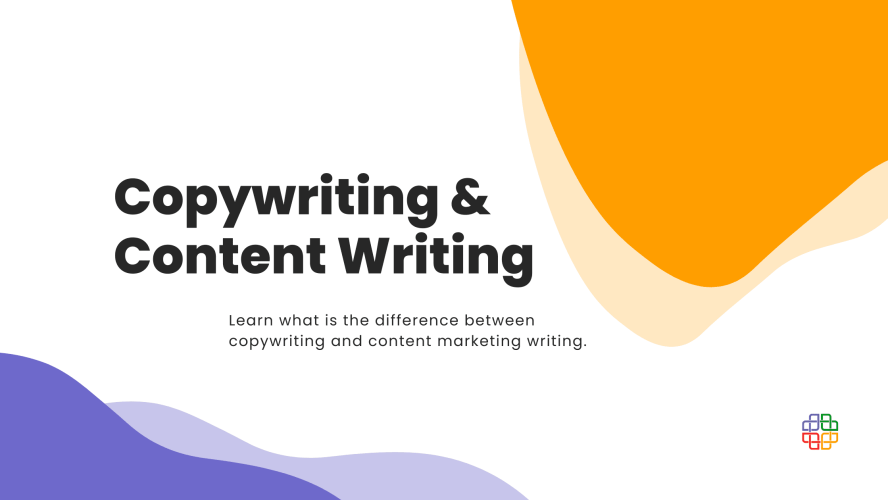When I first started working in this field, I didn’t know exactly what copywriting is. I had a vague idea that it contains writing various texts on request, but nothing more specific than that. And, as it turns out, I’m not the only one. Copywriting is often confused with other types of professional writing services and not everyone knows the difference between them. Let’s explore this topic together.
Copywriting and Content Marketing Writing
Let’s begin with explaining some of the most essential terms.
Copywriting is the act of writing a copy. But what exactly is a copy? The name might be confusing, but it’s actually very simple. Every piece of promotional writing that aims to sell a product, service or brand, we call a copy. So, naturally, copywriting means creating texts that have the intent of selling something. It includes articles, case studies, but also emails, slogans, advertisement brochures, TV and radio ads scripts, and more.
The main characteristic that differentiates copywriting from other types of professional writing, is a call to action. Copy’s main purpose is to generate sales. That’s why it needs to not only inform and convince the reader, but also tell them what to do next. Phrases such as “Buy now” or “Subscribe for a free trial” are all part of the selling mission that copy fulfills.
But not every text that you read online or in a magazine is selling you something, right? Some of them are just informative or offer guidance on a certain topic. That’s what content writing is. It provides the reader with substantive content. The intent is to engage the reader and increase conversion rate. Content writing is often a part of a bigger digital marketing strategy, and fulfills its goals using different types of text – blog posts, social media posts, website written content, email newsletters, etc.
Copywriting vs Content Marketing Writing
Now that we get the idea behind both of these terms, let’s discuss the main differences between them.
Writing purpose
As we explained earlier, copywriting’s main purpose is selling. On the contrary, content writing doesn’t have to directly sell anything. It’s written to generate awareness and interest in a certain brand, organization, company, event, service or product, by discussing topics related to its area of operation in an engaging and useful way.
Form of delivery
Content writing is typically digital, while copywriting can be performed on many different platforms outside the Internet, such as newspapers, banners, TV, etc.
Search Engine Marketing
SEM is composed of two major elements: Search Engine Optimization (SEO) and Pay-Per-Click (PPC). These are two sides of the same coin and to make sure your business is successful on the Internet, both should be taken into consideration.
When it comes to copywriting and content writing, both are in some way engaged in SEM. However, their areas of main focus are different. Copywriting will be more concentrated on PPC. It includes paid Google Ads that are involved in the process of generating sales. On the other hand, content writing is putting more effort into SEO, as it helps in building organic traffic and a long-term interest in the content of a website.
Time frame
Copywriting and content writing are operating in different time frames. Copywriting is quick and urgent. Content writing is slow-paced and generates long-term engagement.
It doesn’t necessarily mean that copywriting is a one-time thing and never takes hours or days to finish. For example, email copywriting that aims at converting leads into customers can be spread over a period of many months until it gives a successful result. The reason for it being called urgent is the feeling that it’s supposed to communicate to the receiver. Even the emails that are sent i.e. once every two weeks should always offer some kind of urgent opportunity that the reader will miss if they don’t start acting now. This tactic of urgency inspires people to make decisions quicker and at the same time gives them a clear sense of the next step that they should take.
Content writing doesn’t need that kind of emotion-driven quick pace, because its goals are different. It informs, educates and gradually builds trust for a certain brand or type of product. This trust is necessary to gain customers and sell your offer (which is a copywriter’s task).
You could say that content writing and copywriting live in a symbiotic relationship. They need each other and both are a part of the same chain, but cover different phases of its development.
You can read more about the differences between copywriting and content marketing writing at Forbes.
Who is a copy written for?
When writing a copy your first priority should always be the audience. It is their perspective that shapes your style, content and the form of your text. It’s them whom you must convince in order for your copy to be successful.
To do that, you first need to get to know them well. Who they are, what are their pleasure and pain points, what types of problems they are facing and what solutions they need.
There are two general groups of audiences that copywriting is addressed to: B2C and B2B.
Now, if these mysterious shortcuts don’t sound familiar to you, let us provide a quick explanation:
B2C: Business to Customer
This type of copywriting is directed at individuals. It stresses the benefits that they can gain if they decide to buy a certain product or service. To write a successful B2C copy the author needs to step into the shoes of an individual customer and find out all of the essential challenges that they need a solution for.
B2B: Business to Business
On the other hand, B2B copywriting is directed at businesses. It is focused on benefits that a business will get from buying products or services from the other business. It often contains specific technical information as well as a wholesale pricing offer. Everything that makes your product attractive in the eyes of business owners.
The main character of your story
Whichever of these two models you’re specializing in, the most important thing that you should always remember is that the prospect is the main character of your text. Not your product, service or brand, but the potential customer should be the focus of a successful copy.
For business owners it might be counterintuitive. They want to show their offer in the brightest spotlight and boast about its benefits. But the customer couldn’t care less about it all. The only thing that matters to them is their own self. Don’t get mistaken – it’s not the matter of them being selfish. That’s just how human nature works.
To truly engage and convince your prospects to buy what you’re selling, you need to direct the spotlight at them. Validate their struggles, show that you know and understand the challenges that they’re facing, and offer a solution to make their lives easier. Talk about yourself only in the context of their problems and needs.
If you do this right, the prospects will see an ally in you, someone who cares about them and wants to help. If you do this wrong, they’ll only see an annoying sales person that wants their money. The choice is yours.
The final question
You already know the difference between copywriting and content marketing writing. So I’m going to ask you the final question: Which type of writing does this article belong to? And what about the following CTA button? Copywriting or content marketing writing? I hope you already know the answers




